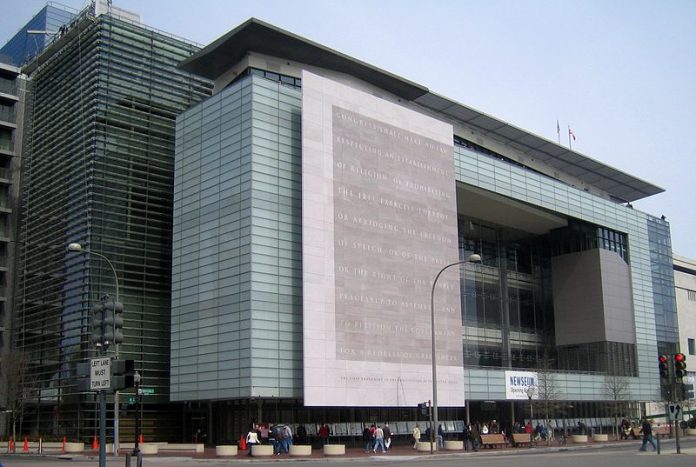WASHINGTON D.C., June 30, 2018 — The names of The Capital Gazette journalists killed Thursday in Annapolis likely will be placed on the Newseum’s Journalists Memorial next year, the head of the Freedom Forum Institute said Friday.
“I would think that the nature of this, the tragedy, the great number of it will mean that their names will unfortunately be on this wall in 2019,” said Gene Policinski, who also is chief operating officer of the Newseum Institute.
Jarrod Ramos is accused of breaking into The Gazette’s offices Thursday afternoon and shooting to death four journalists and one sales staff member before being arrested. He had threatened the newspaper in 2013 in the midst of a lawsuit he filed, saying reporters defamed him by reporting that he was convicted of harassing a former high school classmate online. The lawsuit was later dismissed.
In the aftermath of the attack, law enforcement stepped up security at major news organizations around the country.
Adopting precautionary measures is important, but even the best measures won’t be enough until the ongoing rhetoric against the news media ends, said Frank Smyth, head of Global Journalists Security, a firm that trains journalists in risk mitigation and safety measures. Easy access to firearms and President Donald Trump‘s criticisms about the media are feeding the anger at the root of verbal and physical attacks on journalists, Smyth said.
“Capital Gazette is the worst attack on journalists and press freedom in the history of the U.S.,” he said, comparing The Capital Gazette tragedy to the Charlie Hebdo massacre of 2015 in Paris.
Americans’ have less trust in journalists today “not just because of the frankly ridiculous political debate where journalists are ‘enemies of the people,'” but because there are fewer local journalists covering news that matters to people’s lives, Policinski said.
Trump has called journalists “enemies of the people” and labeled stories as “fake news” regardless of their veracity. During his presidential campaign, he often urged crowds to turn on the reporters covering him, including offering to pay legal bills if someone was arrested for beating up a reporter.
The attack on The Capital Gazette is part of an increase in the number of active shooting episodes in the United States. According to the FBI, there were 30 active shooting episodes throughout the nation last year, the highest number since the 2000s.
While journalists covering international conflicts often face risks, it’s rare for those working in the United States to be targeted. Over the past 26 years, the Committee to Protect Journalists recorded seven other deaths in the country — a relatively small number compared with the 1,306 journalists killed around the world during the same period. “It is a dangerous profession in conflict zones and elsewhere,” said Jennifer Glasse, former foreign correspondent at CNN.
The most striking thing, she said, is that journalists at The Capital Gazette were sitting at the desk of a local paper, not in the midst of a war zone or even violent domestic riot.
Two days before the Annapolis shooting, Milo Yiannopoulos, former senior editor at Breitbart, told a reporter, “I can’t wait for vigilante squads to start gunning journalists down on sight.” When asked to elaborate on his statement, Yiannopoulos said that was his comment was “a troll about ‘vigilante death squads’ as a private response to a few hostile journalists who were asking me for comment.”
The atmosphere of hostility is not only endangering journalists, but also undermining their central role as trusted provider of information, said Tim Franklin, associate dean at Northwestern University’s Medill School of Journalism.
“This tragedy happens against a backdrop of increasing hostility — and violence — directed toward journalists in the U.S. and around the world,” he said. “It is being fomented in some cases by the rhetoric of political leaders. And, it then travels to social media, where that anger is reinforced in echo chambers of partisan vitriol.”






